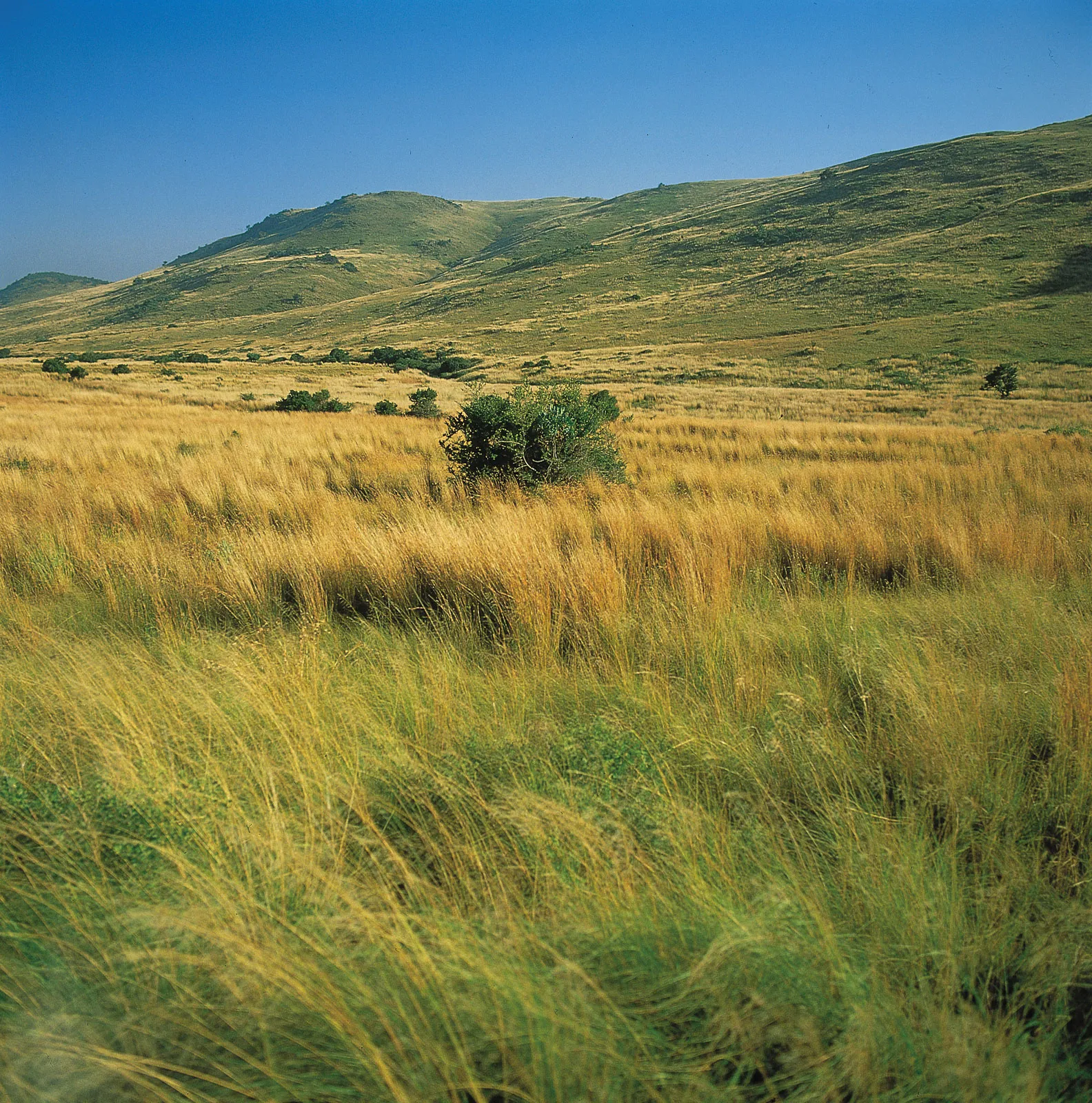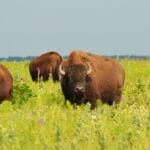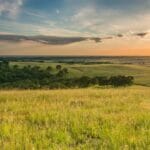Step into the captivating realm of grasslands, the unsung jewels of our planet. These vast landscapes, stretching across every continent save Antarctica, come in a kaleidoscope of forms: temperate savannas alive with teeming wildlife, windswept steppes, and ethereal alpine meadows. Within their unassuming expanse lies an ecological treasure trove – a sanctuary for countless species, a natural pasture for livestock, and a vital guardian of our water and carbon. But this verdant tapestry is now at a crossroads, facing the perils of climate change, vanishing habitats, and unchecked land use. Let’s embark on a captivating journey into the heart of grasslands, unraveling their secrets and underscoring their indispensable role in the delicate equilibrium of our Earth.
All About Grasslands: An Unforgettable Tapestry of Nature
Grasslands, those vast stretches of open land that we often take for granted, are a captivating and surprisingly diverse sanctuary of life. They carpet around a fifth of the world’s landmasses, painting a vibrant canvas of swaying grasses, colorful wildflowers, and countless creatures.
Imagine a place where the sun spills its golden rays, casting a warm glow on the endless sea of grass. Gentle breezes whisper through the slender stalks, creating a symphony of rustling sounds. This is the enchanting world of grasslands.
Grasslands: A Tapestry of Types
Just like a fine tapestry, grasslands come in various forms, each with its own unique charm:
- Natural Grasslands: These untouched havens are nature’s masterpieces, shaped by the rhythms of the seasons and the whims of wildlife.
- Semi-natural Grasslands: A harmonious blend of human influence and nature’s touch, where livestock grazing creates a delicate balance.
- Agricultural Grasslands: These vast expanses are dedicated to feeding our hungry planet, providing a grazing haven for cattle and other animals.
The Symphony of Life in Grasslands
Grasslands are a bustling hub of activity, teeming with a chorus of life. Antelope dance across the plains with graceful abandon, their hooves barely disturbing the delicate grasses. Burrowing owls find sanctuary in the tall stalks, their piercing eyes scanning for prey. The skies reverberate with the melodious songs of larks and meadowlarks, their voices painting a symphony of nature.
Grasslands: Facing Challenges
However, this idyllic tapestry is under siege from a number of human-induced threats:
- Agriculture: The conversion of grasslands into farmland and pastures has fragmented and degraded these vital ecosystems.
- Urbanization: Expanding cities and towns have swallowed up countless acres of grassland habitat, disrupting the intricate balance of life.
- Climate Change: The changing climate, with its unpredictable precipitation patterns and rising temperatures, is putting tremendous strain on grasslands, affecting both plants and animals.
Protecting Our Grassland Heritage
Preserving these grassy landscapes is essential for maintaining the planet’s biodiversity, regulating water cycles, and mitigating climate change. Conservation efforts are focused on:
- Sustainable Grazing Practices: Ensuring responsible livestock grazing that minimizes damage to grasslands while sustaining wildlife.
- Habitat Protection: Establishing protected areas and safeguarding remaining natural grasslands for future generations.
- Restoration: Restoring degraded grasslands, bringing them back to their pristine condition and rekindling the tapestry of life.
By embracing these protective measures, we can ensure that grasslands continue to grace our planet, enriching the lives of humans and wildlife alike.
Discover why burrowing animals and ground-dwelling birds are common in grasslands and how wildfires help maintain savannas and grasslands . Also, learn about the importance of grasslands and their role in our ecosystem.
Where Are Grasslands Found?
If you’re picturing a grassy field, you’re on the right track. Grasslands are like expansive meadows, but they’re not just for frolicking. They’re vital ecosystems covering a quarter of our planet’s surface. Let’s embark on an exploration of these vast grassy realms.
Grasslands thrive in areas where rain is plentiful enough to nurture grasses, but not so abundant as to foster trees. They spread across vast swaths of land, inhabiting every continent save Antarctica. You’ll often find them snuggled up next to forests or deserts, or stretching out in the heart of continents. And get this: they can even scale the heights of mountains!
Key Insights:
- Grasslands span the globe, except for that chilly Antarctica.
- They’re a major player, occupying 25% of Earth’s landmass.
- Forests and deserts are grassland neighbors, and they’re also at home in mountain ranges.
- Grasslands host an impressive array of plants and animals that call it home.
So, Why Are Grasslands Important?
Like all ecosystems, grasslands play a crucial role in the balance of the natural world. They:
- Provide food and shelter for countless creatures, including grazing animals and predatory birds.
- Act as natural water filters, purifying water before it enters our rivers and streams.
- Create soil, which is essential for agriculture and plant life.
- Store carbon, helping to regulate the Earth’s climate.
Types of Grasslands
Not all grasslands are created equal. They come in different shades and flavors:
| Grassland Type | Description | Location |
|---|---|---|
| Temperate grassland | Mild temperatures, lush vegetation, plenty of rainfall | North America, Europe, Asia |
| Tropical grassland | Warm temperatures, tall grasses, seasonal rainfall | Africa, South America, Australia, India |
| Mediterranean grassland | Dry summers, wet winters, shorter grasses | Mediterranean region, California, Chile, South Africa |
| Alpine grassland | Found at high altitudes, cold temperatures, short grasses | Mountains around the world |
How We Can Protect Grasslands
Grasslands face threats from habitat loss, overgrazing, and climate change. Here’s what we can do to lend a helping hand:
- Reduce our consumption of meat and dairy products.
- Support sustainable grazing practices.
- Conserve land for grassland preservation.
- Advocate for policies that protect grasslands.
By nurturing our grasslands, we safeguard a vibrant and invaluable ecosystem for generations to come.
What are the different types of grasslands?
Picture this: a vast green canvas where wind-blown grasses sway gently, creating a mesmerizing ballet of nature. Welcome to the world of grasslands, diverse ecosystems that span the globe.
But hold on, not all grasslands are created equal! Let’s dive into the intriguing world of their different types:
Savannas: Tropical Paradises
Imagine the iconic African savanna, where towering acacia trees dance amidst lush grasses. Savannas thrive in tropical regions, where the rhythm of wet and dry seasons dictates their pulse. During the rainy season, these grasslands burst into vibrant life, becoming havens for wildlife like elephants, lions, and zebras.
Temperate Grasslands: A Temperate Tapestry
North America’s prairies, Eurasia’s steppes, and Argentina’s pampas are prime examples of temperate grasslands. These vast expanses experience a seasonal ballet of moderate rainfall and temperatures. In spring, wildflowers paint the landscape in a kaleidoscope of colors, while bison, pronghorns, and wolves roam freely.
Flooded Grasslands: Wetlands’ Embrace
Where wetlands and floodplains intertwine, you’ll find flooded grasslands. Water weaves its magic through these meadows, creating a sanctuary for specialized plants and animals that thrive in the dance of rising and falling water levels.
Montane Grasslands: Reaching for the Heights
As you climb higher into the mountains, the landscape transforms into montane grasslands. These alpine meadows are a refuge for plants and animals that have adapted to the challenges of altitude. Edelweiss, the iconic mountain flower, and ibex, the sure-footed climber, are just a few of the charismatic species that call these grasslands home.
Desert Grasslands: Thriving in Aridity
In the embrace of deserts, where rainfall is a precious commodity, desert grasslands emerge. These resilient ecosystems showcase the extraordinary adaptability of life. Resilient grasses and unique desert-dwelling animals thrive in these harsh conditions.
Key Takeaways:
- Grasslands come in a mesmerizing array of types, each with its own unique character.
- Savannas dance to the rhythm of the tropics.
- Temperate grasslands paint the landscape with seasonal colors.
- Flooded grasslands adapt to the watery pulse of wetlands.
- Montane grasslands reach for the sky, providing havens in the mountains.
- Desert grasslands thrive in the face of aridity.
What is the ecological significance of grasslands?
Think of grasslands as vast carpets of grasses and flowers that stretch as far as the eye can see. They might not be as attention-grabbing as towering forests or mysterious oceans, but they play a crucial role in keeping our planet spinning on its axis.
A Wildlife Haven
Grasslands are the ultimate party spot for wildlife. They’re like a giant buffet for herbivores like zebras and antelopes, who can munch on the yummy grasses all day long. But wait, there’s more! These herbivores are the main course for carnivores like lions and leopards, creating a never-ending cycle of life and sustenance.
Food on Our Plates
Grasslands are like farming gold. Their rich soils and wide-open spaces make them the perfect spot to graze livestock. Cows, sheep, and goats can roam freely, providing us with milk, cheese, meat, and other tasty treats. Without grasslands, our food supply would be in big trouble.
Carbon Crunchers
Grasslands are also superheroes in the fight against climate change. As grasses grow, they slurp up carbon dioxide, the greenhouse gas that’s warming our planet. They then store this carbon in their roots and soil, like a giant underground vault. By doing so, grasslands help keep our planet cool and comfortable.
Nature’s Helpers
But that’s not all! Grasslands are like free maids for the planet. Their roots hold the soil in place, preventing it from eroding like a melting ice cream. They also act like natural water filters, keeping our precious water clean and pure. And let’s not forget pollination, where bees and other insects help plants make new seeds. Without grasslands, these vital ecosystem services would be in jeopardy.
Key Points to Take Away:
- Grasslands are homes for a huge variety of plants and animals.
- They’re essential for farming animals, which provide us with food.
- Grasslands help reduce climate change by storing carbon.
- They provide important benefits like water filtration, soil protection, and pollination.
FAQ
Q1: What are grasslands?
A1: Grasslands are vast, open areas dominated by grasses and grass-like plants, occurring where rainfall is sufficient to support grasses but not trees.
Q2: Where are grasslands found?
A2: Grasslands are found on every continent except Antarctica, covering between 20-40% of the Earth’s land area. They typically occur in regions with moderate rainfall, transitioning between forests and deserts.
Q3: What are the different types of grasslands?
A3: There are various types of grasslands, including tropical savannas, temperate grasslands, flooded grasslands, montane grasslands, and desert grasslands. Each type is characterized by distinct plant communities, climates, and geographic locations.
Q4: What is the ecological significance of grasslands?
A4: Grasslands play a vital role in ecosystems by providing habitats for diverse flora and fauna, contributing to biodiversity. They also contribute to food security through livestock grazing and play a role in carbon storage and climate regulation.
Q5: What are the threats to grasslands?
A5: Grasslands face threats from human activities such as agriculture, urbanization, and climate change. Conversion to croplands and grazing can fragment and degrade grasslands, while climate change impacts rainfall patterns and vegetation growth.
- Unlock 6000+ words beginning with he: A comprehensive analysis - April 20, 2025
- Mastering -al Words: A Complete Guide - April 20, 2025
- Master Scrabble: High-Scoring BAR Words Now - April 20, 2025
















